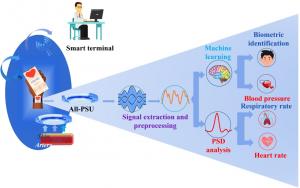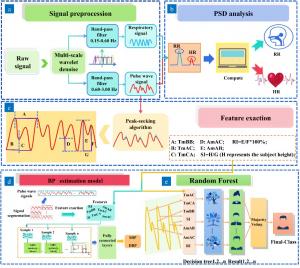
Cardiorespiratory Function Assessment and Biometric Recognition with Intelligent Photonic Wristband
Dual Guardianship of Health and Safety
CHENGDU, SICHUAN, CHINA, May 30, 2025 /EINPresswire.com/ -- Cardiorespiratory function assessment and biometric identification contribute to evaluating an individual's respiratory and cardiac health status, thereby enabling personalized health management. In daily life, respiratory diseases such as various types of influenza, pneumonia, and sleep apnea syndrome, as well as cardiac diseases like hypertension, coronary heart disease, and heart failure, occur frequently. Monitoring cardiorespiratory function to assess, diagnose, and intervene early in respiratory and cardiac diseases is crucial for personalized health assessment and significantly reducing the mortality rates associated with these conditions. Traditional methods for cardiorespiratory function monitoring often require professional and bulky equipment, such as cardiac ultrasound machines, electrocardiographs, and CT scans. With the continuous progress of modern society and the increasing demand for personalized healthcare, there has been a significant rise in the need for intelligent health monitoring devices that can perform biometric identification and cardiorespiratory function assessment accurately and portably.Currently, most optical fiber sensors are based on silica optical fibers or polymer optical fibers. Silica optical fiber sensors are relatively brittle and may pose a risk of tissue damage if they break during long-term contact with the human body, raising concerns about their safety in use. Although traditional polymer optical fiber sensors exhibit significantly improved tensile properties compared to silica optical fibers, their performance is still limited. Novel elastomeric polymer optical fibers can effectively address this limitation, greatly expanding their application scenarios. However, these fibers currently still suffer from issues such as excessive transmission loss. Additionally, current research is generally constrained by limited functionality and low system integration. Therefore, the development of a device that combines long-term real-time cardiorespiratory function monitoring and biometric identification capabilities would significantly expand its service dimensions in the field of personalized medicine, providing new technological support for precise health management.
To address the aforementioned issues, Prof. Rui Min from Beijing Normal University and Prof. Di Zheng from Southwest Jiaotong University, in collaboration with Professor Arnaldo Leal Junior from the Federal University of Espírito Santo in Brazil, Professor Santosh Kumar from the Koneru Lakshmaiah Education Foundation in India, Professor Beatriz Ortega from the ITEAM Research Institute of the Polytechnic University of Valencia in Spain, and Professor Carlos Marques from the University of Aveiro in Portugal, have proposed a wearable smart photonic wristband capable of cardiorespiratory function assessment and biometric identification. The core sensing unit of this wristband is a composite optical fiber constructed based on polymer optical fibers and Solaris elastomeric optical fibers. The integration of the composite optical fiber, Dragon Skin 10 film, and a glycerol-filled fluid sac forms an all-polymer sensing unit. This all-polymer design and integrated sensor fabrication method fully leverage the advantages of polymer optical fibers and elastomeric optical fibers, ensuring rapid response and recovery times. Additionally, this sensor exhibits remarkable long-term stability and durability, consistently delivering outstanding performance under various conditions, such as bending, stretching, and more than 1000 cycles of repetition strain, while also ensuring effective monitoring of pulse wave signals even when the wearing position is slightly offset. Neural network algorithms are fully utilized to achieve accurate blood pressure estimation and biometric identification. Experimental results indicate that the smart photonic wristband performs well in various application scenarios, including monitoring physiological information during different physical activities such as squats, burpees, and high knees. It also facilitates biometric identification for individuals with varying body mass indices. Furthermore, the wristband offers continuous, real-time monitoring capabilities, underscoring its potential application in personal health services for the treatment and prevention of cardiorespiratory diseases.
In summary, the wearable smart photonic wristband proposed in this work achieves precise assessment of cardiorespiratory function and effective biometric identification. It not only excels in response speed, long-term stability, and durability but also maintains high-precision monitoring across various application scenarios and individual differences, demonstrating its practicality and adaptability. Additionally, the demonstration of biometric identification capabilities opens up new possibilities for personal health services. This research finding holds broad application prospects in the prevention, treatment, and daily health management of cardiorespiratory diseases, and is expected to have a positive impact on people's healthy lives.
Di Zheng, Ph.D., is an associate professor at the School of Information Science and Technology, Southwest Jiaotong University. He has been engaged in research in novel optical fiber sensing and detection technologies, intelligent optical fiber sensing systems, microwave photonic sensing, and related fields for a long time. He has presided over multiple projects, including those funded by the National Natural Science Foundation of China and the Sichuan Provincial Natural Science Foundation. He has published over 50 papers in high-impact journals such as Optics Letters, Optics Express, IEEE Journal of Lightwave Technology, and Acta Optica Sinica, among others. Additionally, he holds more than ten authorized national invention patents.
Rui Min, Ph.D., is an associate professor at the Beijing Normal University. He is also recognized as a "Tang Scholar" at Beijing Normal University. His primary research interests encompass fiber-optic physiological information analysis, optical brain-computer interfaces, fiber-optic imaging, and fiber-optic ocean monitoring. Dr. Min has led the research projects such as the National Key Research and Development Program and the National Natural Science Foundation of China. He has published over 150 papers in internationally renowned journals and conferences, with cited more than 3,500 times and achieving an H-index of 32. He has been granted four national invention patents. Additionally, he serves as an associate editor for journals including Optics Express, IEEE Sensors Journal, and Frontiers in Physics, a member of the editorial board for Fiber and Integrated Optics, and a young editorial board member for Advanced Fiber Materials, Measurement, Instrumentation, and Brain-X.
Andrew Smith
Charlesworth
+44 7753 374162
marketing@charlesworth-group.com
Visit us on social media:
YouTube
Distribution channels: Book Publishing Industry, Education, Electronics Industry, Science, Technology
Legal Disclaimer:
EIN Presswire provides this news content "as is" without warranty of any kind. We do not accept any responsibility or liability for the accuracy, content, images, videos, licenses, completeness, legality, or reliability of the information contained in this article. If you have any complaints or copyright issues related to this article, kindly contact the author above.
Submit your press release

